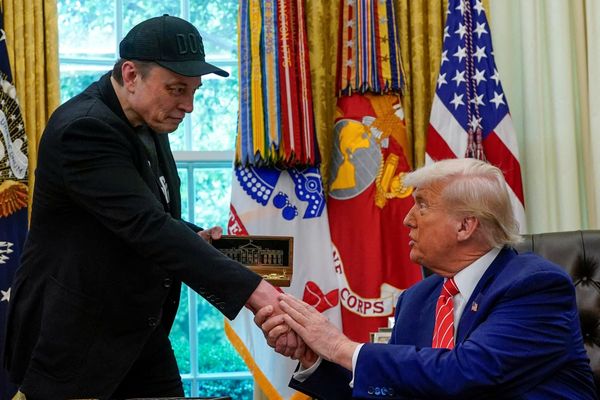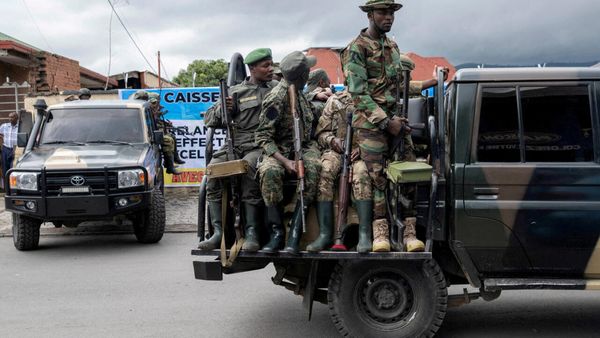
December 2013
Media reports suggest the Abbott government will establish a royal commission to investigate allegations of union “slush funds”, following revelations about practices at the Australian Workers Union (AWU) and Health Services Union.
February 2014
The government confirms the establishment of the commission, names retired high court judge Dyson Heydon as commissioner and sets out terms of reference. It names five unions that will come under particular scrutiny. ACTU secretary Dave Oliver says Tony Abbott is determined to “smear and damage unions rather than get to the bottom of any genuine issues of corruption”.
April 2014: the first session
Heydon insists in his opening remarks that the commission’s “terms of reference do not assume that it is desirable to abolish trade unions”. Rather, “they assume the desirability of unions having legitimate functions within the law”.
Jeremy Stoljar, counsel assisting the commission, makes his opening statement against the background of the Julia Gillard/Australian Workers’ Union (AWU) affair; the saga of Kathy Jackson, Craig Thomson and the Health Services Union; and the CFMEU-Grollo conflict in Victoria.
He says the commission will examine union “slush funds” and “whether persons associated with unions have engaged in activities which could involve wrongdoing or corruption”.
May–June 2014
Former AWU official Bruce Wilson and his sidekick Ralph Blewitt appear to answer questions about the AWU’s Workplace Reform Association “slush fund”, which Blewitt describes as a “vehicle” to raise money for elections. Renovations to Gillard’s house are also the subject of scrutiny, as is Blewitt’s statement to police.
Kathy Jackson denies using HSU money for personal expenses and says she was admitted to a psychiatric hospital in 2011 after finding a shovel on her doorstep in an apparent death threat.
July 2014
All federal departments and agencies are asked to disclose every contact with any trade union for any reason for the past decade, to identify “potential areas of exposure” to the royal commission into union corruption, Guardian Australia reveals.
August 2014
Jackson is cross-examined by a former partner Mark Irving now the barrister for the HSU. She describes him as a “charity shag” and the ongoing legal scrutiny of her use of union funds as “judicial gang rape”. Bill Shorten, Jackson alleges, is part of a “corrupt little gang” that tried to put the union into administration as part of a vendetta against her.
Shorten says the royal commission has become “a platform for people to settle scores” and declines to comment further.
September 2014: Julia Gillard gives evidence
Gillard appears at the commission to answer questions about the AWU “slush fund” and whether any money from it was used to renovate her house. As Guardian Australia political editor, Lenore Taylor, writes, they are:
allegations that have followed her for more than two decades. They involve a colourful cast of characters – an ex-lover, his former mate and “bagman”, lawyers and politicians, and a truckload of tradesmen including Bill “the big Greek bullshit artist” and a woodworker called Athol James.
In the wash-up, we learn very little that’s new. Taylor again:
After a whole day under oath we learned precious little more about the former prime minister’s involvement in the “slush fund scandal” other than some detail of her displeasure upon coming home from holidays in Queensland to find that her boyfriend had demolished her ugly red and yellow bathroom and the astonishing fact that she received invoices from tradesmen before she paid them, and then afterwards, receipts.
October 2014
Stoljar says Gillard did not commit a crime, but recommends Jackson and CFMEU Victorian secretary John Setka both be charged with offences including corruption, blackmail and embezzlement.
Tony Abbott – then PM – and Denis Napthine –then Victorian premier – announce a police taskforce into unions. George Brandis, the federal attorney general, extends the commission’s reporting date until December 2015 at a cost of $8m.
“There are dimensions of criminal conduct revealed by the evidence thus far suggesting that a more thorough examination … is desirable,” commissioner Heydon says. Legal scholars say the federal government won’t get any “political paydirt”, even with an extension.
November–December 2014
Gillard hits back at the commission, saying the claim of unprofessional conduct made by counsel assisting Stoljar “lacks real substance”. She later calls for an apology from Coalition members for the sake of “decency”.
The commission’s interim report is released on 19 December, to little fanfare; most of the major developments will be left to 2015. Industrial relations reporter Paul Karp writes in Comment is Free that it “caps off ... a stagnant year for the federal government in terms of industrial relations achievements”.
February-May 2015
Documents show Jeremy Stoljar is paid $3.3m for two years’ work at the commission. Questions are raised about the relationship between the Electrical and Trades Union and the Labor party. Karp says the commission is in murky territory, in another piece for the Guardian: “is it possible for Turc to make a judgement about union members’ interests, without also judging the probity and effectiveness of the ALP?”
June–July 2015: Bill Shorten gives evidence
Shorten offers to be questioned by the commission as his time as AWU Victorian state secretary comes under scrutiny in the media. At issue is whether deals made by Shorten with bosses primarily benefited the AWU – and strengthened the power of its leaders – rather than workers.
Abbott says Shorten has questions to answer “about whether – when he was the leader of the Australian Workers’ Union – deals were done which ripped off the workers to advantage the union”. Shorten calls it a smear and challenges Abbott to “make my day” at a town hall debate about workers’ rights.
A 2005 deal in which a Melbourne building firm Winslow Constructors paid the AWU for workers’ union memberships comes under particular scrutiny. Abbott says Labor faces an “existential crisis” because of allegations raised at the commission.
Labor frontbencher Brendan O’Connor says the commission is feeding unsubstantiated claims to the media and denying people “natural justice”.
It has acted in a sensational manner about matters that are not proven, it has made findings against people who have not been called and has not made findings against those where there is damning evidence already given ...
A camera phone video somehow makes its way to the media the day before Shorten is to appear at the commission. In the video, he gives a stump speech to a cheering crowd at a pub, covering a range of issues from marriage equality to university fees and ending with the hope Australians can live in a country “where people can organise to have a strong minimum wage and will not be subject to a royal commission.”
Shorten appears at the commission and has his “credibility as a witness” called into question by Heydon:
A witness who answers each question ‘yes’, ‘no’, ‘I don’t remember’ or clarifies the question and so on gives the cross-examiner very little material to work with. It’s in your interest to curb these, to some extent, extraneous answers.
Guardian Australia’s deputy political editor, Katherine Murphy’s analysis:
Obviously Shorten’s objective was not full and frank disclosure of events long past, his objective was to get through the process without the commission being able to land any killer blows. It was a rational objective, and Shorten succeeded. There really wasn’t a killer blow, despite what you might read in some publications.
The net result was that Shorten reinforced his status as a “hollow man”, an “uninspiring and slightly shifty bureaucrat”, and “the man from nowhere”. Shorten described himself as a “consensus builder”.
More allegations of corruption and intimidation are made against the CFMEU, which boycotts hearings in Canberra.
August 2015: Dyson Heydon scandal
Commissioner Heydon is revealed to have been booked to speak at a Liberal party fundraiser. Labor and the ACTU call for the inquiry to be shut down and threaten boycotts. Brandis recommends Dyson’s “absolutely stainless reputation for punctilious integrity”.
The ACTU threatens to take Heydon to the high court; the commissioner claims he “overlooked” the link between the Sir Garfield Barwick lecture and its Liberal party organisers.
After delays, Heydon rejects calls to disqualify himself for apprehended bias. His reasons, Richard Ackland writes, “involve various definitional refinements, akin to a delicatessen slicing the prosciutto very finely”. Labor floats a motion in the Senate to press the governor general to get involved, which sinks. The ACTU backs off too.
September–November 2015
The commission announces it has no intention to call Shorten for further hearings despite allegations about an election worker being raised. He is later “cleared of wrongdoing” in a late-night release from the commission.
The commission is accused of “modern-day McCarthyism” by Victorian Labor after an order is given to produce members’ details, which is later dropped. A week later Victorian Labor suspends internal elections after claims of branch-stacking using prepaid credit cards.
More hearings are held about the CFMEU, regarding documents shredded and thrown on bonfires, a bad tattoo paid for with a union credit card and donations taken from Chinese developers. CFMEU official John Lomax is cleared of blackmail.
Claims of corruption are made against Victorian MP and former AWU secretary Cesar Melhem. Premier Daniel Andrews reserves judgment until the conclusion of the commission.
Kathy Jackson’s home is raided by police. It is announced that complaints against her partner, fair work commissioner Michael Lawler, will be independently investigated.
December 2015: the final report
Setka and deputy Shaun Reardon are arrested and charged with blackmail, sparking massive protests in Melbourne. Shorten announces new union governance rules ahead of the release of the commission’s final report.
The commission releases its final report, recommending that a regulator similar to the Australian Securities and Investments Commission be established to stamp out union corruption. Jackson is found to have “lied repeatedly”. She and Melham are both referred for prosecution, as are others.
The commission, which started hearing evidence in March 2014, has cost $45.9m – coming in under the $53.3m allotted to it in the 2014 budget.
In all, it received evidence from 505 witnesses over 189 days of hearings, held in Sydney, Melbourne, Brisbane, Perth and Canberra.







